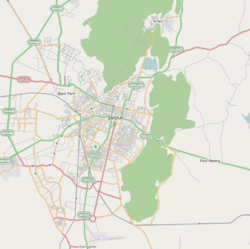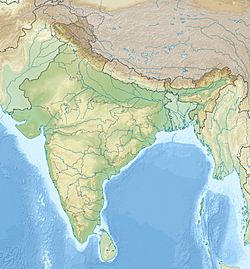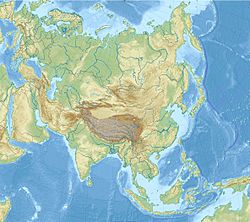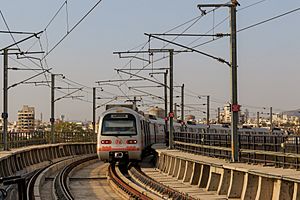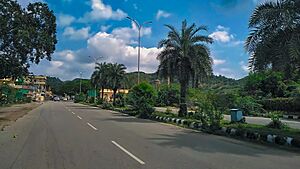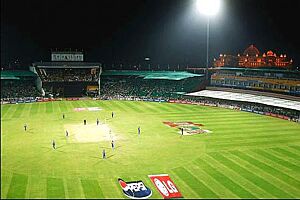Jaipur facts for kids
Quick facts for kids
Jaipur
|
|
|---|---|
|
City wall of Jaipur
Amber Fort
Birla Mandir
Jal Mahal
Albert Hall Museum
Jantar Mantar
World Trade Park
|
|
| Nickname(s):
The Pink City
|
|
| Country | |
| State | |
| District | Jaipur |
| Founded | 18 November 1727 |
| Founded by | Jai Singh II |
| Government | |
| • Type | Municipal Corporation |
| • Body | Jaipur Municipal Corporation |
| Area | |
| • Total | 467 km2 (180 sq mi) |
| Area rank | 1st in Rajasthan |
| Elevation | 431 m (1,414 ft) |
| Population
(2011)
|
|
| • Total | 3,046,189 |
| • Rank | 10th India |
| • Density | 6,523/km2 (16,894/sq mi) |
| Demonyms | Jaipuri, Jaipuriya, Jaipurite |
| Language | |
| • Official | Hindi |
| • Additional official | English |
| • Regional | Rajasthani |
| Time zone | UTC+05:30 (IST) |
| Pincode(s) |
3020xx
|
| Area code(s) | +91-141 |
| Vehicle registration | RJ-14 (Jaipur South) RJ-45 (Jaipur North) |
| GDP Nominal (Jaipur district) | ₹192,668 crore (US$33 billion) |
| Budget | ₹895.60 crores ($121 million) |
| Airport | Jaipur International Airport |
| Rapid transit system | Jaipur Metro |
| Website | (Jaipur Greater) (Jaipur Heritage) |
| Official name: Jaipur City, Rajasthan | |
| Criteria: | Cultural: (ii), (iv), (vi) |
| Designated: | 2019 (43rd session) |
| Reference #: | 1605 |
| Region: | Southern Asia |
Jaipur (pronounced Jai-poor) is the capital and largest city of Rajasthan, a state in northwestern India. As of 2011, about 3.1 million people live there, making it the tenth most populated city in the country. Jaipur is located about 268 kilometers (166 miles) from New Delhi, the capital of India. It is often called the Pink City because many of its old buildings are painted a beautiful pink color.
Jaipur was founded in 1727 by Jai Singh II, a ruler from the Kachhwaha Rajput family. He was the ruler of Amer, and the city is named after him. Jaipur is one of the first planned cities in modern India, designed by an architect named Vidyadhar Bhattacharya. During the time of British rule, Jaipur was the capital of the Jaipur State. After India became independent in 1947, Jaipur became the capital of the new state of Rajasthan in 1949.
Today, Jaipur is a very popular place for tourists in India. It's part of the "Golden Triangle" tourist route, which also includes Delhi and Agra. Jaipur is also a starting point for visiting other amazing places in Rajasthan like Jodhpur and Udaipur. The city has two World Heritage Sites: Amer Fort and Jantar Mantar. In 2019, Jaipur was officially added to the list of World Heritage Cities. Because of its beauty, some people even call it the "Paris of India."
Contents
What's in a Name?
Jaipur gets its name from Jai Singh II (1693-1744), who was the ruler of Amer. He founded the city in 1727. In the ancient Indian language of Sanskrit, the word "pur" or "pura" often means "city" or "town." So, "Jaipur" basically means "The City of Jai" or "Jai's City," honoring Maharaja Jai Singh II who built it.
A Glimpse into Jaipur's Past
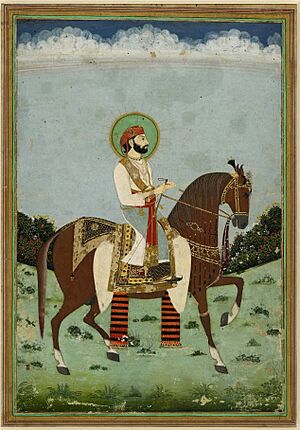
Jaipur was founded by the Rajput chief Jai Singh II on November 18, 1727. He ruled from 1699 to 1743. He decided to move his capital from Amber to Jaipur because the population was growing, and there wasn't enough water in Amber. Jai Singh worked with several architects to plan Jaipur's layout. He designed the city based on ancient Indian building principles called Vastu Shastra and Shilpa Shastra, with Vidyadhar Bhattacharya as the main architect. Building the city started in 1726.
Later, during the rule of Sawai Ram Singh II, the city was painted pink. This was done to welcome Albert Edward, Prince of Wales in 1876. Many streets in Jaipur are still painted pink today, which gives the city its unique look and its famous nickname, the Pink City.
In the 1800s, Jaipur grew quickly. By 1900, it had a population of 160,000 people. The wide streets were paved, and the city became known for working with metals and marble. In 1981, heavy rains caused flooding in large parts of the city, including the airport. On July 6, 2019, Jaipur was officially added to the World Heritage Cities list.
Jaipur's Location and Environment
Where Jaipur Is
Jaipur is located in the northeastern part of Rajasthan and covers an area of about 467 square kilometers (180 square miles). The city is surrounded by flat, fertile land to the east and south. To the north and west, there are hills and desert areas. Jaipur generally slopes downwards from north to south. The Aravalli hills surround the city, with Nahargarh hills in the north and Jhalana in the east.
The Dravyavati River is the main waterway in Jaipur. By 2014, it had become very polluted. To fix this, a plan was made in 2015 to clean up the river. A 13-kilometer (8-mile) section of the riverfront was opened in 2018 after being cleaned, and the rest of the project was finished in 2022.
Jaipur's Weather
Jaipur has a hot semi-arid climate. This means it has long, very hot summers and short, mild to warm winters. Most of the rain falls in July and August during the monsoon season. This makes the average temperatures in these months a bit cooler than in drier May and June. During the monsoon, there are often heavy rains and thunderstorms, but big floods are not common.
The hottest temperature ever recorded in Jaipur was 49.0°C (120.2°F) on May 23, 1994. From December to February, the average temperature stays below 20°C (68°F). These months are mild, dry, and pleasant, sometimes a bit chilly. The coldest temperature ever recorded was -2.2°C (28.0°F) on January 31, 1905, February 1, 1905, and January 16, 1964.
People of Jaipur
| Historical population | |||||||||||||||
|---|---|---|---|---|---|---|---|---|---|---|---|---|---|---|---|
| Year | 1881 | 1891 | 1901 | 1911 | 1921 | 1931 | 1941 | 1951 | 1961 | 1968 | 1971 | 1981 | 1991 | 2001 | 2011 |
| Pop. | 142,600 | 158,900 | 160,000 | 137,100 | 120,200 | 144,200 | 175,800 | 291,000 | 403,400 | 533,200 | 636,800 | 1,004,700 | 1,518,200 | 2,322,575 | 3,073,350 |
| ±% | — | +11.4% | +0.7% | −14.3% | −12.3% | +20.0% | +21.9% | +65.5% | +38.6% | +32.2% | +19.4% | +57.8% | +51.1% | +53.0% | +32.3% |
| Source: Census of India | |||||||||||||||
According to a 2011 report, Jaipur city had a population of 3,073,350 people. Most people in the city can read and write, with a literacy rate of 84.34%. For every 1,000 males, there were 898 females.
Languages Spoken
The official language of Jaipur is Hindi, and English is an additional official language. The main local language spoken in the city is Dhundari. You'll also hear Marwari and Standard Hindi dialects, along with English.
Religions
| Religion in Jaipur City (2011) | ||||
|---|---|---|---|---|
| Religion | Percent(%) | |||
| Hinduism | 77.9% | |||
| Islam | 18.6% | |||
| Jainism | 2.4% | |||
| Others | 1.1% | |||
Based on the 2011 census, most people in Jaipur are Hindus, making up 77.9% of the population. The next largest group is Muslims (18.6%), followed by Jains (2.4%), and then other religions (1.1%).
How Jaipur Makes Money
Jaipur is important for Rajasthan's economy. Besides being the state capital and a center for education and government, Jaipur's economy relies on tourism, cutting gemstones, making jewelry, creating fancy textiles, and information technology.
Several big business groups have offices in Jaipur, like the Federation of Indian Chambers of Commerce & Industry (FICCI). In 2008, Jaipur was ranked among the top 50 emerging cities for global outsourcing.
Jaipur has become a center for car and machinery industries. Companies like JCB and Hero MotoCorp have factories here. There are also chemical manufacturers like Emami. The city is also one of India's top growing IT (Information Technology) hubs. Mahindra World City is a special business area in Jaipur with many software and IT companies. The government of Rajasthan has even built Asia's largest business incubator for startups, called the Bhamashah Techno Hub, in Jaipur.
Jaipur is famous for its arts and crafts. You can find many traditional shops selling old items, jewelry, handmade goods, gems, and textiles. Jaipur is one of the biggest makers of hand-knotted rugs in India. The Jaipur foot, a special rubber-based artificial leg for people who have lost a part of their leg, was designed and is made in Jaipur. The World Trade Park Jaipur is a large shopping mall that opened in 2012.
Culture and City Life
Places to Visit
Jaipur is a major tourist spot in India and is part of the famous Golden Triangle tour. In 2015, TripAdvisor named Jaipur the best Indian destination to visit.
The Jaipur Exhibition & Convention Centre (JECC) is Rajasthan's largest center for events and exhibitions. Some of the popular places to visit include the Albert Hall Museum, Hawa Mahal, Jal Mahal, City Palace, Amer Fort, Jantar Mantar, Nahargarh Fort, Jaigarh Fort, and Birla Mandir. The Jantar Mantar observatory, which has 19 old astronomical instruments, and Amer Fort are both World Heritage Sites. The Hawa Mahal is a five-story building shaped like a pyramid with 953 windows. It stands 50 feet (15 meters) tall. Sisodiya Rani Bagh and Kanak Vrindavan are beautiful parks in Jaipur.
Jaipur's Unique Culture
Jaipur has many cultural places like Jawahar Kala Kendra and Ravindra Manch. The Government Central Museum displays various arts and old items. There's also a government museum at Hawa Mahal. You can see statues around the city that show Rajasthani culture. Jaipur has many traditional shops selling old items and handicrafts.
The rulers of Jaipur used to support many arts and crafts. They invited skilled artists and craftspeople from all over India and other countries to live in the city. Some of these crafts include bandhani (tie-dye), block printing, stone carving, making silver jewelry, and blue pottery.
Jaipur also has its own performing arts. The Jaipur Gharana is one of the main styles of Kathak, a classical North Indian dance. This style is known for its fast, detailed dance moves and lively body movements. The Ghoomar is a popular folk dance. Tamasha is an art form where Kathputli puppet dances are performed as plays.
Major festivals celebrated in Jaipur include Elephant Festival, Gangaur, Makar Sankranti, Holi, Diwali, Vijayadashami, Teej, Eid, Mahavir Jayanti, and Christmas. Jaipur is also famous for the Jaipur Literature Festival, which is the world's largest free literature festival. Writers and literature lovers from all over the country come to this event.
City Design
The city was planned in 1727 by Vidyadhar Bhattacharya using the Indian Vastu shastra principles. It has three main gates facing east, west, and north. The eastern gate is called Suraj pol (sun gate), the western gate is Chand pol (moon gate), and the northern gate faces the old capital of Amer. The city's design was greatly influenced by the Mughal architecture of the 17th century.
Jaipur was divided into nine blocks. Two of these blocks were for royal buildings and palaces, and the other seven were for the public. Large walls were built around the city with seven strong gates. What's special about Jaipur compared to other old Indian cities is how regular its streets are. The city is divided into six main areas by wide streets that are 34 meters (111 feet) wide. These areas are further divided by a grid of smaller streets. Five of these areas surround a central palace area, with a sixth area just to the east. The palace area includes the Hawa Mahal palace, beautiful gardens, and a small lake. Nahargarh Fort, where King Jai Singh II lived, sits on a hill in the northwest part of the old city.
Local Food
Some typical dishes in Jaipur include Dal Baati Churma, Missi Roti, Gatte ki Sabzi, and Laal Maans. Jaipur is also known for its sweets like Ghevar, Feeni, Mawa Kachori, and Gajak.
Getting Around Jaipur
By Air
Jaipur International Airport is located in the southern part of the city, about 13 kilometers (8.1 miles) from Jaipur. It is one of the busiest airports in India for daily flights. In 2015–2016, the airport handled over 2.5 million domestic passengers and 363,899 international passengers. Jaipur Airport also handles air cargo. Sometimes, flights heading to Indira Gandhi International Airport in Delhi are sent to Jaipur Airport if there's heavy fog in Delhi. The airport became an international airport on December 29, 2005.
By Train
Jaipur Junction railway station was built in 1875 and is in the center of Rajasthan. It's the busiest station in Rajasthan, serving almost 35,000 passengers every day. The current railway station building was started in 1956 and took three years to build. The station uses solar energy to power its operations. Jaipur is the main office for the Jaipur Railway division and the North Western Railway Zone of Indian Railways.
- Metro
The Jaipur Metro started running on June 3, 2015. It was built in phases. The first part, called Phase 1A, is mostly elevated and covers 9.63 kilometers (5.98 miles) from Mansarovar to Chandpole Bazaar. Construction started in 2010 and finished in 2014. The Jaipur Metro is India's sixth metro rail system. It's also the first metro in India to run on a triple-story structure that combines an elevated road and a metro track. Phase 1-B, from Chandpole to Badi Chaupar, started operating on September 23, 2020.
By Road
Jaipur is located on National Highway No.48, which connects Delhi and Mumbai. National Highway 52 links Jaipur with Kota, and National Highway 21 connects Jaipur with Agra.
The RSRTC (Rajasthan State Road Transport Corporation) operates bus services to major cities in Rajasthan and other states like Delhi, Uttar Pradesh, and Madhya Pradesh. City buses are run by Jaipur City Transport Services Limited (JCTSL). This service uses over 400 regular and low-floor buses. Major bus stations are in Vaishali Nagar, Vidyadhar Nagar, and Sanganer.
The Jaipur Ring Road is a project by the Jaipur Development Authority to help reduce traffic in Jaipur. It connects several national highways around the city and is 150 kilometers (93 miles) long. A 57-kilometer (35-mile) section of this six-lane road has already been completed.
Learning in Jaipur
In the past, Jaipur had three colleges, including a Sanskrit college (from 1865) and a girls' school (from 1867), which opened during the rule of Maharaja Ram Singh II. Today, public and private schools in Jaipur follow the "10+2" plan, which means eight years of primary education and four years of secondary education. English and Hindi are the languages used for teaching.
Some important educational places in Jaipur include the University of Rajasthan, Rajasthan University of Health Sciences, Malaviya National Institute of Technology, and LNM Institute of Information Technology.
Staying Connected
Major phone companies like Airtel, Jio, and VI provide mobile services in Jaipur. There are also many internet service providers. The government of Rajasthan has started offering free WiFi in public places like Central Park and Jantar Mantar.
News and Entertainment
Major daily newspapers in Jaipur include Rajasthan Patrika, Dainik Bhaskar, and The Times of India. The state-owned All India Radio broadcasts on both medium wave and FM. There are also several private FM radio stations like Radio Mirchi (98.3 MHz) and Radio City (91.1 MHz). The public broadcaster Doordarshan also has a regional channel.
Sports in Jaipur
The main cricket stadium in Jaipur is Sawai Mansingh Stadium. It can hold 30,000 people and has hosted national and international cricket matches. It's also the home ground for the IPL team Rajasthan Royals. Other sports venues in the city include Sawai Mansingh Indoor Stadium and Chaugan Stadium. A new cricket stadium is planned for Chonp Village that will hold 75,000 people, making it one of the largest cricket stadiums in the world.
Jaipur is represented in the IPL by the Rajasthan Royals and in the Pro Kabaddi League by the Jaipur Pink Panthers.
Images for kids
-
Sawai Jai Singh, the founder of Jaipur
See also
 In Spanish: Jaipur para niños
In Spanish: Jaipur para niños










